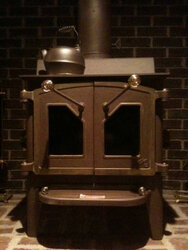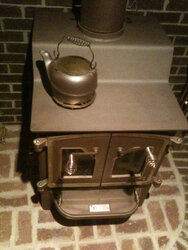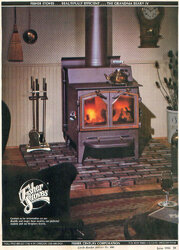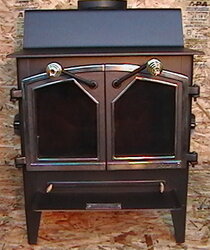I may just keep the factory baffle plate as it is and make a whole new one for it at work, i have access to equipment to make a very nice one that will be fitted for my chimney, as far as the secondary burn setup i am somewhat lost with that, still reading over your post and trying to visualize it, i would definitely be interested in making one, i love to tinker and make things, i am an industrial mechanic by trade.
Looking for help with Grandma lll stove
- Thread starter Fisherman221
- Start date
-
Active since 1995, Hearth.com is THE place on the internet for free information and advice about wood stoves, pellet stoves and other energy saving equipment.
We strive to provide opinions, articles, discussions and history related to Hearth Products and in a more general sense, energy issues.
We promote the EFFICIENT, RESPONSIBLE, CLEAN and SAFE use of all fuels, whether renewable or fossil.
You are using an out of date browser. It may not display this or other websites correctly.
You should upgrade or use an alternative browser.
You should upgrade or use an alternative browser.
I plan on going on over this stove and respraying it the factory color this spring as well as polishing up the brass accents on it, its really a beautiful stove and looks great in my workshop, i still need to get the factory hinge pins for the left door as i am currently using 3/8 hitch pins which work very well but i want to keep it as original as possible, i also need to figure out what seal i need for the doors as there is not currently one on it, doesnt even appear there ever was, paint is still very clean in the channel on the stove.
Any recommendations as far as adjustable stove pipe elbows and stove pipe to use? Is there a certain manufacturer everyone goes with or type? I see there is quite variety of them
You guys really are great here, thanks for all the input and most certainly thanks to you coaly for your help and your willingness to share you knowledge, hoping to get this beautiful machine fine tuned and running as efficiently as possible, i have electric heat upstairs and a buck stove insert in my living room which i thought sucked and now its even more confirmed since having the fisher. Coaly if you are on the lookout for certain stoves i am pretty good at finding things online and am always looking, i can definitely pass along anything i find that you would be interested in especially since we are not very far from each other, prior to buying this stove i had the opportunity to buy a 76 bicentennial grandpa bear for $200 that was in pretty decent shape from what i could see, i just felt it wasnt a very good fit for me, however i am not certain its still available for sale.
Normally open. Only when a chimney over drafts is a damper needed to slow the draft. The only way to tell for sure if you should be using the damper is a draft gauge at stove outlet. Other things affect draft such as any exhaust fans running in the home, a clothes dryer exhausting outside, gas or oil burning water heaters and furnaces all reduce the air pressure within the home that the chimney competes with. In some cases you can get draft reversal with a few exhaust fans on that start using the chimney as the building air intake. With a stove not going all summer, you can smell "chimney" walking past the stove and know the chimney draft would be slowed considerably with mechanical fans. It doesn't take much to overpower chimney draft. Even heat moving away from a stove and rising up steps rapidly (or air leaks on an upper floor exhausting indoor air outside through cracks) reduces chimney draft. This can cause smoke to leak from intake vents and is called "stack effect" since the building is acting like a chimney. So with a bath exhaust or kitchen range exhaust fan on, running a damper partially closed could slow the draft too much. Experience is needed with each system, simply too many variable to be able to tell anyone where to set a damper.Regarding closing off primary vents and opening air wash vents to check draft is that with the damper fully opened?
Thanks, I have one of the first made Grandpa Bear prototypes.
I see Facebook Marketplace has quite a few Fishers. I'll be a regular there now. I see the prices are just as crazy as everywhere else.
Ace Hardware around here has the best selection of connector pipe parts.
I like Dura-Black by Dura-Vent and home Depot is the cheapest. It is heavy duty pipe, formed not crimped. Good stuff. Only problem is they only put it out in seasonal. Installs in the summer have to wait for parts until it gets cold...... Lowe's always has it on the shelf. They don't sell Dura-Vent.
I prefer the solid corrugated els if they don't have to be adjustable. Much stronger and don't leak. I only find them on Amazon.
Any leaks into pipe, chimney or stove allows cooler indoor air to leak in (lower pressure area inside) which cools the chimney being detrimental to draft and creosote formation.
You'll find the thickness of HVAC pipe is much less than black pipe which is required by code as well.
The Buck Insert should be a good heater. Probably the chimney. The chimney is the engine that drives the stove. It creates the draft needed to get oxygen into the sealed box. Make sure it is connected to a liner the same size as the stove outlet. The chimney is more important than the stove.
I see Facebook Marketplace has quite a few Fishers. I'll be a regular there now. I see the prices are just as crazy as everywhere else.
Ace Hardware around here has the best selection of connector pipe parts.
I like Dura-Black by Dura-Vent and home Depot is the cheapest. It is heavy duty pipe, formed not crimped. Good stuff. Only problem is they only put it out in seasonal. Installs in the summer have to wait for parts until it gets cold...... Lowe's always has it on the shelf. They don't sell Dura-Vent.
I prefer the solid corrugated els if they don't have to be adjustable. Much stronger and don't leak. I only find them on Amazon.
Any leaks into pipe, chimney or stove allows cooler indoor air to leak in (lower pressure area inside) which cools the chimney being detrimental to draft and creosote formation.
You'll find the thickness of HVAC pipe is much less than black pipe which is required by code as well.
The Buck Insert should be a good heater. Probably the chimney. The chimney is the engine that drives the stove. It creates the draft needed to get oxygen into the sealed box. Make sure it is connected to a liner the same size as the stove outlet. The chimney is more important than the stove.
The buck stove was setup as a slammer and i dont believe has a liner running to it, just a hood at the bottom above the stove, it was a very old install and came with the house when i bought it, i believe it was never messed with with other than regular cleaning. I have only used it a handful of times, and had my friend who is a roofer check the chimney, it will heat the house upstairs well but like to gobble wood
Chances are it dumps into a larger chimney flue that allows flue gasses to expand, cooling them which slows draft and slows air getting into firebox. The larger flue requires much more heat than a smaller insulated liner, so more heat is wasted up the chimney instead of radiating into house. Buck is a good well built Insert. Don't you dare connect a Fisher Insert that way and give them a bad rep.

If i ever put a fisher insert in i will make sure it has a proper sized liner installed in the chimney, i really dont use the buck stove and am hoping to have this grandma bear doing most of the work since it can heat from the basement up and keep everything warm, i am gonna order some proper elbows and make a proper baffle and get everything setup and monitor flue temps, i am sure she can handle the job! She's already doing great and still not in tip top shape
I plan on going on over this stove and respraying it the factory color this spring as well as polishing up the brass accents on it, its really a beautiful stove and looks great in my workshop, i still need to get the factory hinge pins for the left door as i am currently using 3/8 hitch pins which work very well but i want to keep it as original as possible, i also need to figure out what seal i need for the doors as there is not currently one on it, doesnt even appear there ever was, paint is still very clean in the channel on the stove.
Color is Metallic Brown by Stove Bright.
Polish should be for precious metals listed as gold, silver, brass, bronze. Maas is what I use, not aluminum polish for wheels!
Very easy to make hinge pins close to originals. They were solid 3/8 rivets. Use a 3/8 bolt with long enough shank under head without threads. Grind hex points to round. Chuck bolt in drill and run in reverse against a running bench grinder to form round head. Cut to length.
CamFan on this website has some original brass rivets from production at the Georgia plant he will sell you. Not sure if your right side has plated rivets, but they should be. They were available in nickel for nickel plated doors too.
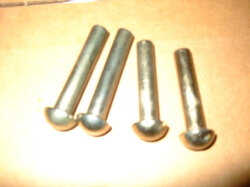
The doors may seal OK without gasket. Normally only glass doors used gasket material. Yours should have had flat gasket material cemented in the 1 inch channel iron door seal. It prevents the door from closing with a crash with glass. Much quieter too. Rutland Stove and Gasket Cement is getting hard to find. Lowe's has Imperial brand that works similar. Not difficult to install. Simply close doors lightly to crush and hold in place until dry, fire for final cure.
Keep the hinge pins greased with high temp grease or silver anti-seize! Same as the bolt threads the draft caps spin on. Your draft caps may be solid brass as well. You can tell by removing one. Check the back. Aluminum caps are very light compared to the heavy brass. You can tell by the feel of spinning them once you try both.
Thanks for the pointers! I would be interested in a set of those pins if they are still available, i saw they have replacements on ebay but they arent brass, that would be a very nice touch when i refinish the stove in the spring, the stove does have aluminum draft caps and the left side needs some attention, it does not fully open, maybe 2.5 turns fully, the right side seems to have 4 turns, i will have to take them apart clean them and then go over them with anti seize, i think i actually have some high temp copper antiseize too
SpaceBus
Minister of Fire
View attachment 238760 View attachment 238761 Model III glass (sold for $1626 on eBay Nov. 2010!)
View attachment 238762 Model IV has larger glass with angled contour at top. View attachment 238763
Those really are sharp. They have a bit of a Gothic look.
Well i got the extended baffle installed, made from 5/16 stainless steel plate also used small beam clamp to hold it in place, that way it can be adjusted or removed, original baffle was welded to the angle iron in the stove so i didnt feel like going through the trouble of trying to remove it, i also made some nice stainless steel door pins for the stove, kind of bummed they dont match real well, maybe i will invest in brass ones when i refinish the stove, door gasket will be here tomorrow, i got my ir thermometer to moniter flue and stove temps better, everything seems to be coming along, next is to order some corrugated elbows to get rid of the galvanized ones stove seems to not rip through the wood as quickly on first burn, i am really liking it soo far


Does the same rules apply with the ir thermometer reading flue pipe temps as the burn indicator magnet? If so i am good, reading 350 on the pipe approx just below heat reclaimer and 175 just above it, stove top temp is right around 475 i jist started stove with 5 small sticks of wood and have only been burn for 30 minutes
SpaceBus
Minister of Fire
I would ditch the heat exchanger and just use single wall stove pipe for the entire run. You are also burning wood fast because you have it cribbed. That's letting a ton of air through the wood. Great for small hot fires, not great for large burns you want to last for a while. Cribbing the wood is great to start your stove and get it hot quickly and get the flue hot enough to prevent creosote buildup. Once your small starting load has burned down to coals, rake them to the front and load the stove fairly full with firewood all oriented in the same direction, doesn't matter which. Run the stove pipe up to 400-450f and then turn the intake air down until you still have combustion and your flue is over 250 f. This will help give you a long burn and still keep your flue clean.
I had the wood cribbed becuase i was just starting it cold and didnt want an extended burn, I just wanted to test the baffle and some temps, i think when i order the corrugated elbows i am gonna get rid of the heat reclaimer then, it is nice but seems to be very much disliked by people who have a much better understanding and way more knowledge on this than myself, i will say that the stove seems to behave much better and seems like it produces a slower more efficient burn now, (but what do i know i am new to this) that the baffle is in place, i measure everything out and made sure the it was right, i also noticed that coming back to the stove later i found no coals and just ash, i would assume that is a good thing.
I really appreciate everyones input and helps with this, its nice to know that there are people out there willing to help and give feedback, i did noticed today when i check my chimney at the roof it have very low visible smoke, next to none, and could see the heat coming out of the chimney, ( gases i would assume are somewhat visible?)
SpaceBus
Minister of Fire
The baffle is definitely a good thing and most certainly will help your burn times. I've seen some folks fabricate secondary burn manifolds in older stoves and then it's not far behind a modern EPA stove in emissions and efficiency. I am not an expert, so I'm not going to recommend to modify your stove, do so at your own risk.
Todd67
Minister of Fire
A baffle plate in my Fisher is the only mod I needed to add. Nothing fancy, just keep it simple.
So it is to my understanding that the stove should have a door seal, however i ordered some 5/8" wide by 1/8" thick door gasket material and tried to install it today, it did not work at all, i placed it in the channel on the stove face and the doors in the middle were sticking out and i couldnt even get the latch to lock, did they ever make these stoves designed to not use a seal?
All Fisher Stoves without glass are designed to make contact in 3 places all the way around on the door sealing channel iron.
The web of the channel iron makes contact with the raised portion of the door. It also makes contact with the two edges of channel iron on the back of the door. That is the 3 points of contact all the way around. There is no clearance for gasket in the center. You can normally add only the flat gasket if the hinge pins and holes are worn, or if it had a poor fit when the hinge plates were welded to the stove front. If you can put a piece of cardboard in the channel and close the doors normally, there is a good chance it needs gasket. Yours probably has the hinge plates positioned to hold the doors tight against seal and there was no room for gasket as you're finding. The glass door stoves were supposed to have gasket, I believe it is only to prevent the shock when closing doors abruptly.
The III style with smaller glass had gasket material in the channel, (I have not seen one that didn't) the later IV with larger glass had no channel iron welded to stove and had gasket cemented to doors. They require gasket since there is no iron door seal at all on them.
One thing that happens is when gasket crushes and falls apart, the cement stays in the channel and increases the gasket thickness when more cement is added to attach new gasket. The old gasket cement should be removed with a wire wheel down to bare metal, or even thin gasket material can be too thick.
Notice when you latch doors, they do not touch the stove front. The back of the doors should only contact the seal and the thickness of the channel iron web is the same as the space (gap) you will see from stove face to back of door. A stove made for gasket material will have loose doors without the seal thickness since there is a clearance space for gasket. Clearance is about 1/2 the thickness of gasket so it crushes to seal. Chances are that when your doors were fitted, the hinge plates were welded in place with the doors setting on the stove front. (the stove is laid on its back, doors are centered over sealing channel iron and hinge plates are tacked in place) They were probably welded the way they should be to get a good seal on a solid door, closing tight against door seal without gasket clearance. When you close all the air intakes, the fire should die to a glow or go out. If it flames, you have leakage.
The web of the channel iron makes contact with the raised portion of the door. It also makes contact with the two edges of channel iron on the back of the door. That is the 3 points of contact all the way around. There is no clearance for gasket in the center. You can normally add only the flat gasket if the hinge pins and holes are worn, or if it had a poor fit when the hinge plates were welded to the stove front. If you can put a piece of cardboard in the channel and close the doors normally, there is a good chance it needs gasket. Yours probably has the hinge plates positioned to hold the doors tight against seal and there was no room for gasket as you're finding. The glass door stoves were supposed to have gasket, I believe it is only to prevent the shock when closing doors abruptly.
The III style with smaller glass had gasket material in the channel, (I have not seen one that didn't) the later IV with larger glass had no channel iron welded to stove and had gasket cemented to doors. They require gasket since there is no iron door seal at all on them.
One thing that happens is when gasket crushes and falls apart, the cement stays in the channel and increases the gasket thickness when more cement is added to attach new gasket. The old gasket cement should be removed with a wire wheel down to bare metal, or even thin gasket material can be too thick.
Notice when you latch doors, they do not touch the stove front. The back of the doors should only contact the seal and the thickness of the channel iron web is the same as the space (gap) you will see from stove face to back of door. A stove made for gasket material will have loose doors without the seal thickness since there is a clearance space for gasket. Clearance is about 1/2 the thickness of gasket so it crushes to seal. Chances are that when your doors were fitted, the hinge plates were welded in place with the doors setting on the stove front. (the stove is laid on its back, doors are centered over sealing channel iron and hinge plates are tacked in place) They were probably welded the way they should be to get a good seal on a solid door, closing tight against door seal without gasket clearance. When you close all the air intakes, the fire should die to a glow or go out. If it flames, you have leakage.
I did try to do the dollar bill test earlier and found that the dollar seemed to have even tension all the way around, installing the door gasket just didnt work and i removed it, (waste of $15 lol) after just trying what you said about the closing all the air dampers it pretty much made the fire go out, just some very lazy dark orange flames were left, very minimal
Similar threads
- Replies
- 5
- Views
- 735
- Replies
- 3
- Views
- 1K
- Replies
- 5
- Views
- 529
- Replies
- 1
- Views
- 405


